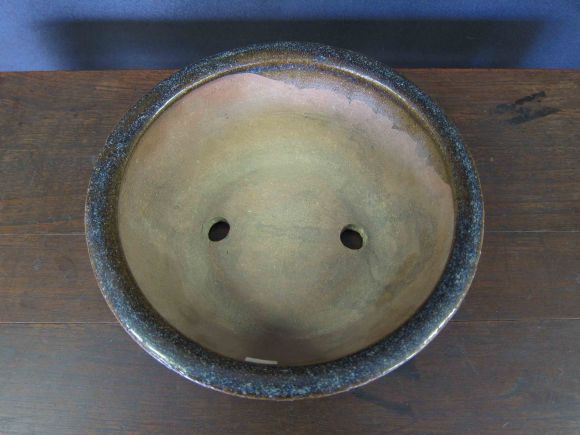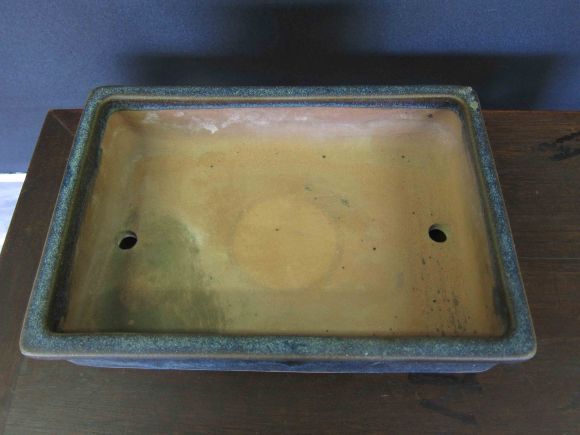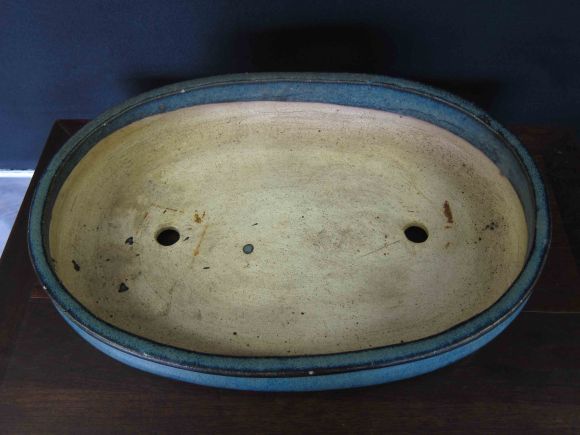Lets talk ceramics in this post! Since there is so much to say about ceramics in Bonsai, it’s difficult to find a good place to start. After much thought, I decided to start with a certain glazed style that I love called Namako. Usually when people in the bonsai community sees a pot in this glaze, they will refer to them as a Namako pots or containers. In Japan, Namako actually means Sea cucumber and in many ways share the same pattern and color as the glaze. There are varying degrees of blues, white, yellow and brown mixed together making each pot very unique. In this post, I’m going to share some detailed pictures of Namako pots from the past to the present, both Chinese and Japanese and talk about some way to distinguish them from one another.
A Rocky Start
Before I came to Japan, I did not like Namako pots. I talked to Mr. Tanaka and he said, “Really???” It turns out that my experience with Namako has been the poor quality types that were mass produced. Once Mr. Tanaka showed me a couple of Chinese Antique Namako pots, I quickly fell in love with them and wanted to collect more. Perhaps the biggest reason why this type of glaze is now my favorite is because I dismissed it so quickly in the past and feel a bit guilty for my ignorance. Now all I want to do is collect them and share them with people so they too can enjoy the beauty of them.
Chinese Antique Namako (100-150 years ago) Naka-watari
Lets start with the highest level of Namako pottery. I can’t say for certain that it was used earlier in the past, but in terms of Bonsai, they first appeared about 100-150 years ago. They were produced in China with great care and quality and shipped to Japan about 100-150 years ago. Ceramic pots that were produced in China 100-150 years ago are also known as Naka-watari. There are also Chinese Antique pots that were produced 200-300 years ago known as Ko-watari, but I’ve yet to see one that has this glazed. Chinese Antique pots in this post are all Naka-watari. Current value of Naka-watari Namako pots range from 300 – 5,000 US Dollars depending on size and shape.
 Here is a Namako suiban with a very large lip! (You know I had to start with this one ;op). For those that are unfamiliar with Suibans, they are ceramic containers that can either hold water or sand with a viewing stone. This suiban is Chinese Antique and looks brand new! It has never been used and was protected in a wood box since it was made over 100 years ago.
Here is a Namako suiban with a very large lip! (You know I had to start with this one ;op). For those that are unfamiliar with Suibans, they are ceramic containers that can either hold water or sand with a viewing stone. This suiban is Chinese Antique and looks brand new! It has never been used and was protected in a wood box since it was made over 100 years ago.
 Suibans are normally glazed inside and out, whereas a bonsai pot would be glazed on the outside only.
Suibans are normally glazed inside and out, whereas a bonsai pot would be glazed on the outside only.
 The underside. One easy way to tell that it’s a suiban is that there are no holes, but I’m sure you already figured that one out. Sometimes, people will drill holes into suibans so they can used for Bonsai. I’m not sure if I’d ever do that to this pot though!
The underside. One easy way to tell that it’s a suiban is that there are no holes, but I’m sure you already figured that one out. Sometimes, people will drill holes into suibans so they can used for Bonsai. I’m not sure if I’d ever do that to this pot though!
 I thought you’d like to see the lip up close. ;o)
I thought you’d like to see the lip up close. ;o)
 Lets get down to the details. Many Chinese Antique Namako pots tend to have thick beads of glaze at the bottom of the pot. They will also tend to have a clean line under the bead and show the clay underneath. On this suiban, the bead dripped passed the line a bit but for the most part is pretty straight.
Lets get down to the details. Many Chinese Antique Namako pots tend to have thick beads of glaze at the bottom of the pot. They will also tend to have a clean line under the bead and show the clay underneath. On this suiban, the bead dripped passed the line a bit but for the most part is pretty straight.
 High quality Chinese Antique Namako glazes always seem to have a feeling of depth. When I look at it, I feel like I’m looking deep into a room or color dripping all around.
High quality Chinese Antique Namako glazes always seem to have a feeling of depth. When I look at it, I feel like I’m looking deep into a room or color dripping all around.
 Here’s a close up of the clay. Though the picture can’t replace the pot being in hand, it can give you an idea of the type of clay used 100-150 years ago. Though this is not the only clay type that was used, it is a common type and a good indicator of its age.
Here’s a close up of the clay. Though the picture can’t replace the pot being in hand, it can give you an idea of the type of clay used 100-150 years ago. Though this is not the only clay type that was used, it is a common type and a good indicator of its age.
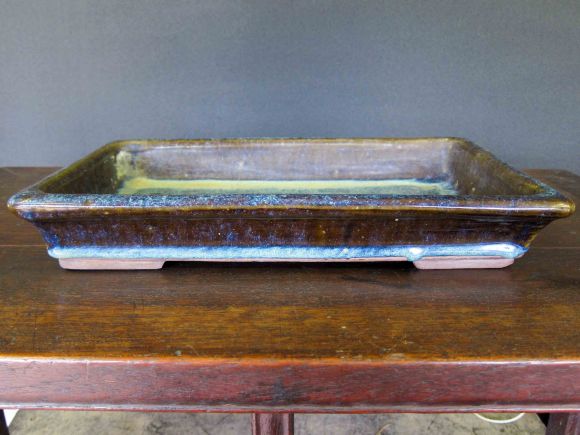 Here is another example of a Namako suiban. Note how this one has more browns and is lighter on the blue. This is also Chinese Antique.
Here is another example of a Namako suiban. Note how this one has more browns and is lighter on the blue. This is also Chinese Antique.
 Here is what the inside looks like. This suiban is not as shinny on the inside because it has been used and a thin layer of patina has developed.
Here is what the inside looks like. This suiban is not as shinny on the inside because it has been used and a thin layer of patina has developed.
 Here is the bottom of the suiban. No chop mark on this one. About half of all Chinese Antique pots have no chop marks on them.
Here is the bottom of the suiban. No chop mark on this one. About half of all Chinese Antique pots have no chop marks on them.
 Here is a close up of one of the feet. Chinese antiques were all made my hand. Looking at the feet is another way of identifying a Chinese Antique pot.
Here is a close up of one of the feet. Chinese antiques were all made my hand. Looking at the feet is another way of identifying a Chinese Antique pot.
 Here is a look at the clay used. Not quite the same as the first suiban but very similar.
Here is a look at the clay used. Not quite the same as the first suiban but very similar.
 Here’s an example of the straight line at the bottom of the pot that Namako’s tend to have. In this instant, a glaze bead ran over the line. Accidental or intentional? Personally, I think the thick beads that pass the line gives the suiban so much more character.
Here’s an example of the straight line at the bottom of the pot that Namako’s tend to have. In this instant, a glaze bead ran over the line. Accidental or intentional? Personally, I think the thick beads that pass the line gives the suiban so much more character.
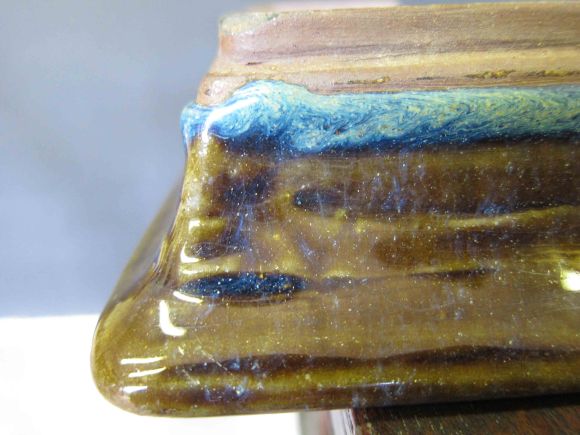 This photo gives us an idea of how thick the glaze is. The glaze is so thick that it has a sense of softness though in reality, the glaze is as hard as glass.
This photo gives us an idea of how thick the glaze is. The glaze is so thick that it has a sense of softness though in reality, the glaze is as hard as glass.
 Here is an example of a Namako pot made for Bonsai.
Here is an example of a Namako pot made for Bonsai.
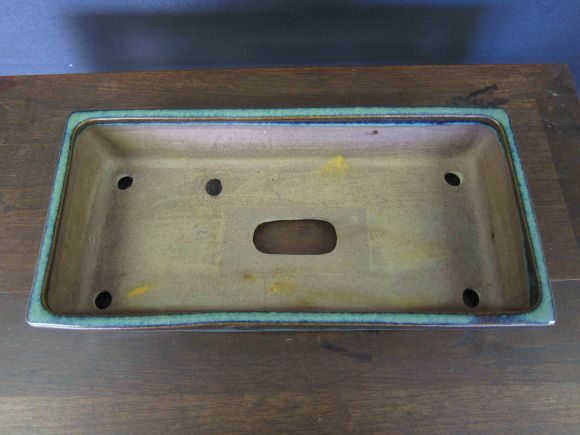 This pot has plenty of holes and is not typical of many Chinese Antique pots.
This pot has plenty of holes and is not typical of many Chinese Antique pots.
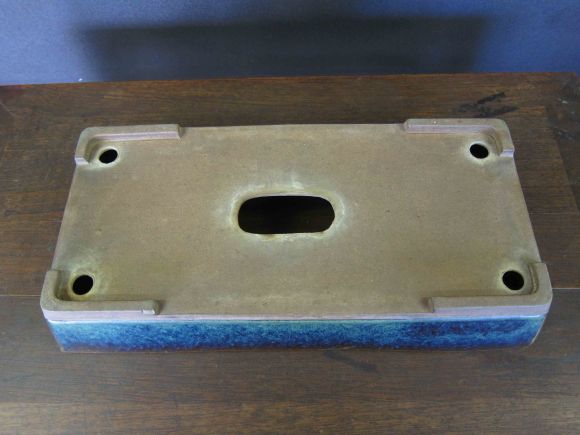 The underside. The imperfection of the center hole tells us that it was done by hand.
The underside. The imperfection of the center hole tells us that it was done by hand.
 Here’s a close up of the feet. Very well made.
Here’s a close up of the feet. Very well made.
 Here is a close up of the drain hole. This is another good indication that it’s a Chinese Antique pot. The holes are normally punched from the inside of the pot, leaving a raised outline on the bottom. Many Chinese Antique pots have this raised outline on the drainage holes.
Here is a close up of the drain hole. This is another good indication that it’s a Chinese Antique pot. The holes are normally punched from the inside of the pot, leaving a raised outline on the bottom. Many Chinese Antique pots have this raised outline on the drainage holes.
 A close up shot of the clay. Again, very similar to the two earlier suibans.
A close up shot of the clay. Again, very similar to the two earlier suibans.
 That deep feeling when looking at the glaze.
That deep feeling when looking at the glaze.
 Here is the lip of the pot. It seems that many times with Namako pots, the edge and corners tend to be brownish and the flat surfaces are bluish.
Here is the lip of the pot. It seems that many times with Namako pots, the edge and corners tend to be brownish and the flat surfaces are bluish.
 Now this one is a tricky one. The Namako glaze is a bit different but there are some key signs that tell us it’s a Chinese Antique. Lets take a closer look.
Now this one is a tricky one. The Namako glaze is a bit different but there are some key signs that tell us it’s a Chinese Antique. Lets take a closer look.
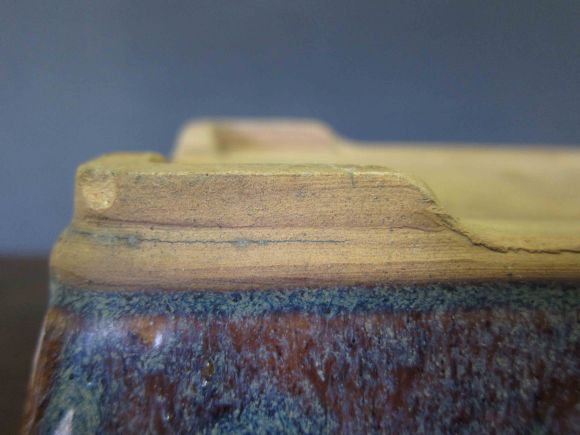 Here’s a close up of the feet. Looks hand made and similar to the second suiban.
Here’s a close up of the feet. Looks hand made and similar to the second suiban.
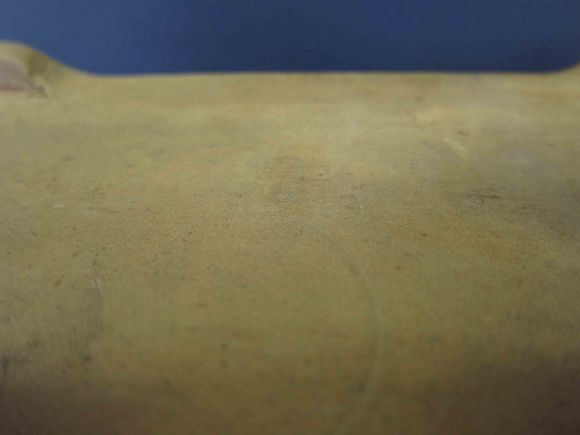 Here’s a close up of the clay. It’s actually a bit lighter then what the picture depicts.
Here’s a close up of the clay. It’s actually a bit lighter then what the picture depicts.
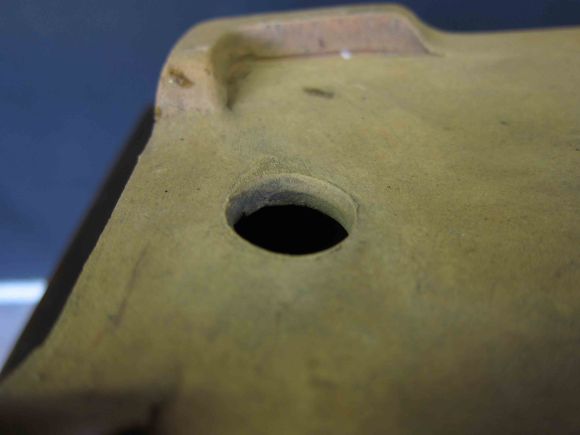 Here’s a shot of the drain holes. The raised edge of the drain holes is one of the indications that it’s a Chinese Antique pot.
Here’s a shot of the drain holes. The raised edge of the drain holes is one of the indications that it’s a Chinese Antique pot.
 Here is a close up of the glaze itself. A very different feel then the previous pots. I talked to Mr. Tanaka about this pot and he confirms that it’s a Chinese Antique pots because of the clay type, drain holes and quality of the pot itself. The glaze patterns are clean and detailed but more random.
Here is a close up of the glaze itself. A very different feel then the previous pots. I talked to Mr. Tanaka about this pot and he confirms that it’s a Chinese Antique pots because of the clay type, drain holes and quality of the pot itself. The glaze patterns are clean and detailed but more random.
Chinese Namako pots during the 70’s
During the early half of the 1900’s, the ceramic quality for Bonsai pots dropped significantly and the rise of Japanese ceramic pottery took hold. During the 1970’s though, there was a big push in China to produced high quality hand made ceramics that resembled the antiques. Unfortunately they never quite reached the quality levels of the antiques and are considered second class to them. These Chinese pots are known as Shinto pots. The current value for Shinto Namako pots range from 80 – 400 US Dollars depending on shape and size. Lets see what they’re all about.
 Here is a shot of the drainage holes. Note how there is no raised outline to the hole.
Here is a shot of the drainage holes. Note how there is no raised outline to the hole.
 The clay type does look very similar to the Chinese Antiques though.
The clay type does look very similar to the Chinese Antiques though.
 Here is a look at the glaze. Though the picture can’t show it, the texture of the glaze is rough and thin whereas the antiques are much thicker and smoother. Also, the glaze quality is somewhat flat, not as clear or detailed.
Here is a look at the glaze. Though the picture can’t show it, the texture of the glaze is rough and thin whereas the antiques are much thicker and smoother. Also, the glaze quality is somewhat flat, not as clear or detailed.
 Here is the glaze on the inside of the pot. This is an example of the thin glaze.
Here is the glaze on the inside of the pot. This is an example of the thin glaze.
 Another example of the thin glaze. Note how there is no beading effect at the glaze line. Though lower in quality relative to the antiques, this pot does have it’s uses and the price is affordable.
Another example of the thin glaze. Note how there is no beading effect at the glaze line. Though lower in quality relative to the antiques, this pot does have it’s uses and the price is affordable.
 Here is another example of a Shinto Namako pot, though there could be some debate about it. This pot was made during that borderline period between Shinto and Shin Shinto. Shin Shinto are the much more modern pots made during the late 80’s to the present. Lets take a closer look at this pot.
Here is another example of a Shinto Namako pot, though there could be some debate about it. This pot was made during that borderline period between Shinto and Shin Shinto. Shin Shinto are the much more modern pots made during the late 80’s to the present. Lets take a closer look at this pot.
 Here is a shot of the feet. Note how the lines aren’t clean and defined.
Here is a shot of the feet. Note how the lines aren’t clean and defined.
 Here is a shot of the drainage hole.
Here is a shot of the drainage hole.
 Here is a closer look at the glaze. Overall, it’s pretty nice but it lacks depth and clarity when compared to the antiques. To be quite honest about it, these pots are the reason why I didn’t like Namako in the first place. :o( Also, there is a chop on the bottom of the pot that says, “Made in China.” Again, the pot does have it uses but I probably wouldn’t use it in a show.
Here is a closer look at the glaze. Overall, it’s pretty nice but it lacks depth and clarity when compared to the antiques. To be quite honest about it, these pots are the reason why I didn’t like Namako in the first place. :o( Also, there is a chop on the bottom of the pot that says, “Made in China.” Again, the pot does have it uses but I probably wouldn’t use it in a show.
Shin Shinto Namako
Recently, Mr. Tanaka purchaced two new Chinese Namako pots and I would have to say that they are pretty nice. Though they are still mass produced and made in molds, the glazes are very interesting to look at and the quality has increased significantly compared to the last two decades. Though not all new Chinese pots are very well made, I believe these are the exceptions, which is probably why Mr. Tanaka bought them.
 Here’s a view from the top. One indication that the pot is Shin Shinto is the numbers of holes in the pot, especially the small holes. The Chinese didn’t make those small holes until recently.
Here’s a view from the top. One indication that the pot is Shin Shinto is the numbers of holes in the pot, especially the small holes. The Chinese didn’t make those small holes until recently.
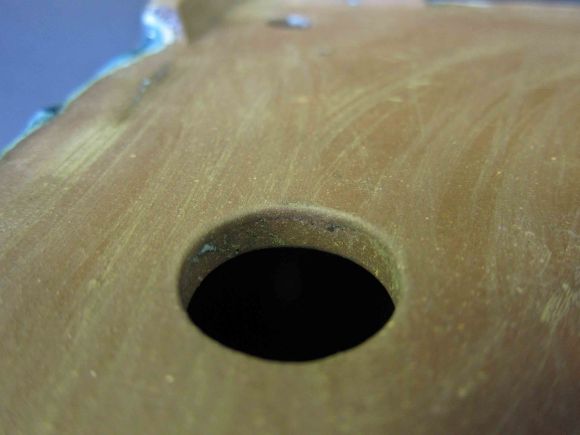 The drain holes are much cleaner then the antiques.
The drain holes are much cleaner then the antiques.
 Here is a closer look at the glaze. A very clear and deep feeling. It feels like the glaze is going to drip onto the ground at any moment.
Here is a closer look at the glaze. A very clear and deep feeling. It feels like the glaze is going to drip onto the ground at any moment.
 Here is a look at the lip of the pot. Glaze is nice and thick. For the most part, I’m not too interested in the current Chinese ceramics because of the mass production feel to them, but this one definitely caught my attention. Now I want one!
Here is a look at the lip of the pot. Glaze is nice and thick. For the most part, I’m not too interested in the current Chinese ceramics because of the mass production feel to them, but this one definitely caught my attention. Now I want one!
Japanese Antique and Modern Namako
Japanese Antique glazed pots tended to be much more rough in style, whereas the more modern glazes are much more refined. This has led to the modern ceramics costing much more then the antiques! The antiques do have their own characteristics though and I would not be so quick to dismiss them. Here is an examples of an antique vs. a modern pot.
 Here is a Japanese Antique Namako pot. They tend to be much bluer and have very little yellows and brown.
Here is a Japanese Antique Namako pot. They tend to be much bluer and have very little yellows and brown.
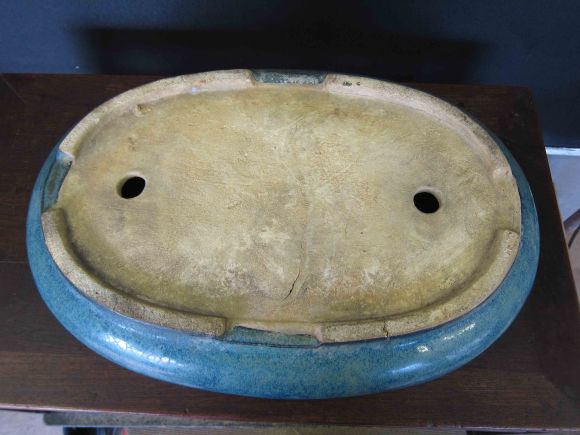 Here is the bottom of the pot. Note the clay color and rough texture. Many Japanese Antique glazed pots use this type of white clay.
Here is the bottom of the pot. Note the clay color and rough texture. Many Japanese Antique glazed pots use this type of white clay.
 Here is the drainage hole. The japanese tend to round out the edges of the drainage holes to make them smoother.
Here is the drainage hole. The japanese tend to round out the edges of the drainage holes to make them smoother.
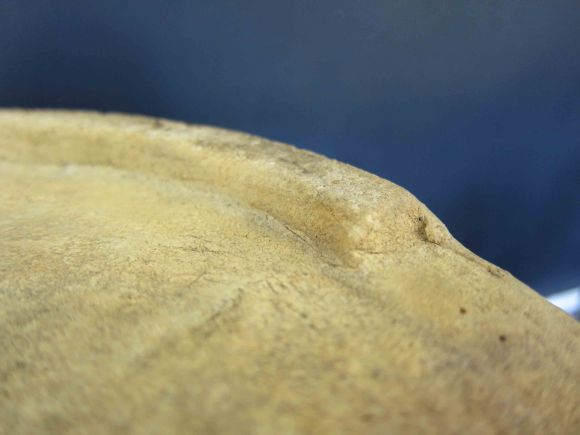 A closer look at the feet. Rough with not much details.
A closer look at the feet. Rough with not much details.
 Here’s a closer look at the glaze. Not bad overall.
Here’s a closer look at the glaze. Not bad overall.
 The end of the lip tends to be black. It must be the different chemicals they use for the glaze. So overall, a pretty nice pot. The clay itself is of lower quality but the glaze isn’t too bad. In Japan, people either like them, or hate them. Personally, I like them for their rough characteristics and the fact that they’ve survived for over 100 years without breaking.
The end of the lip tends to be black. It must be the different chemicals they use for the glaze. So overall, a pretty nice pot. The clay itself is of lower quality but the glaze isn’t too bad. In Japan, people either like them, or hate them. Personally, I like them for their rough characteristics and the fact that they’ve survived for over 100 years without breaking.
 Here is a modern Japanese Namako pot (Modern as in 30 years old).
Here is a modern Japanese Namako pot (Modern as in 30 years old).
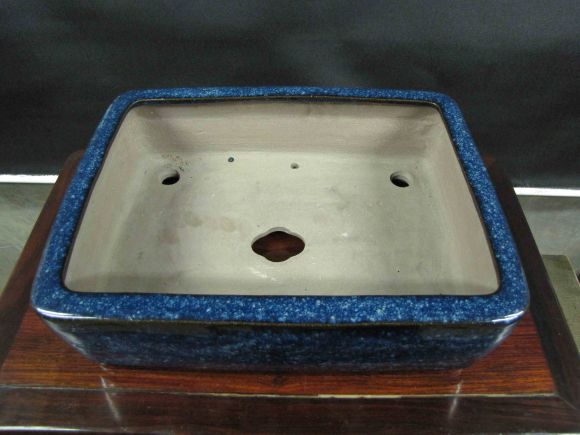 Here is a look at the top of the pot.
Here is a look at the top of the pot.
 Here is the bottom of the pot.
Here is the bottom of the pot.
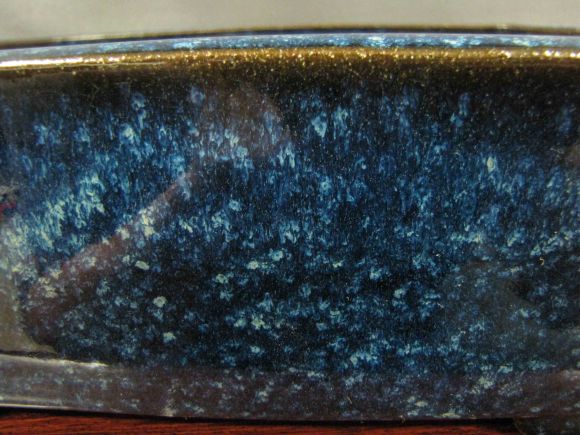 Here is a close look at the glaze. It tends to look more Chinese Antique then Japanese Antique.
Here is a close look at the glaze. It tends to look more Chinese Antique then Japanese Antique.
So What Tree Can I Put In These Pots?
Since Namako has many colors, it can be very attention grabbing. So much so that people focus in on the pot more then the tree itself. Namako pots tend to go well with trees that are just as attention grabbing to balance everything out. Deciduous trees such as Trident Maples, Korean Hornbeams, Japanese Quince and rough bark type elms look very nice in these pots, because of the roughness and details of the trunk and branches. Many root over rock deciduous trees also tend to look very nice in these pots.
 Here’s a Trident Maple in a Namako pot. Unfortunately this is the only example of have at the moment, but rest assure, I will share more pictures of trees in Namako pots in the future!
Here’s a Trident Maple in a Namako pot. Unfortunately this is the only example of have at the moment, but rest assure, I will share more pictures of trees in Namako pots in the future!
In Conclusion
I hope that this post gave you some insight not just about Namako pots, but the different country origins and time period they came from. Perhaps you have a Namako pot that you weren’t so sure about before and more a better idea where it came from. So have you decided which type of Namako you like? All of them? None of them?
There is so many different types of pottery and makers that it can be a full blown hobby and profession in itself. For me, it’s hard to love Bonsai and not love the ceramics as well. The right combination of tree and container can really bring out the best in both. Trying new shapes, colors and sizes can be very fun and exciting during the repotting season. The container in Bonsai is fundamental. It’s the, “Bon,” in Bonsai!
Thanks for reading.
P.S. If you are actively reading this blog, I would appreciate it if you subscribe to it (right column of the blog). This is one of the best ways for me to know how many people are reading. Thanks!



